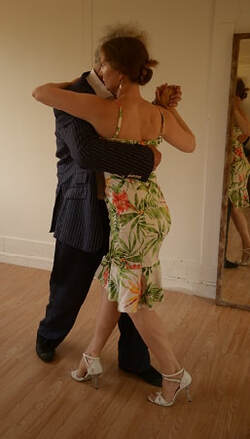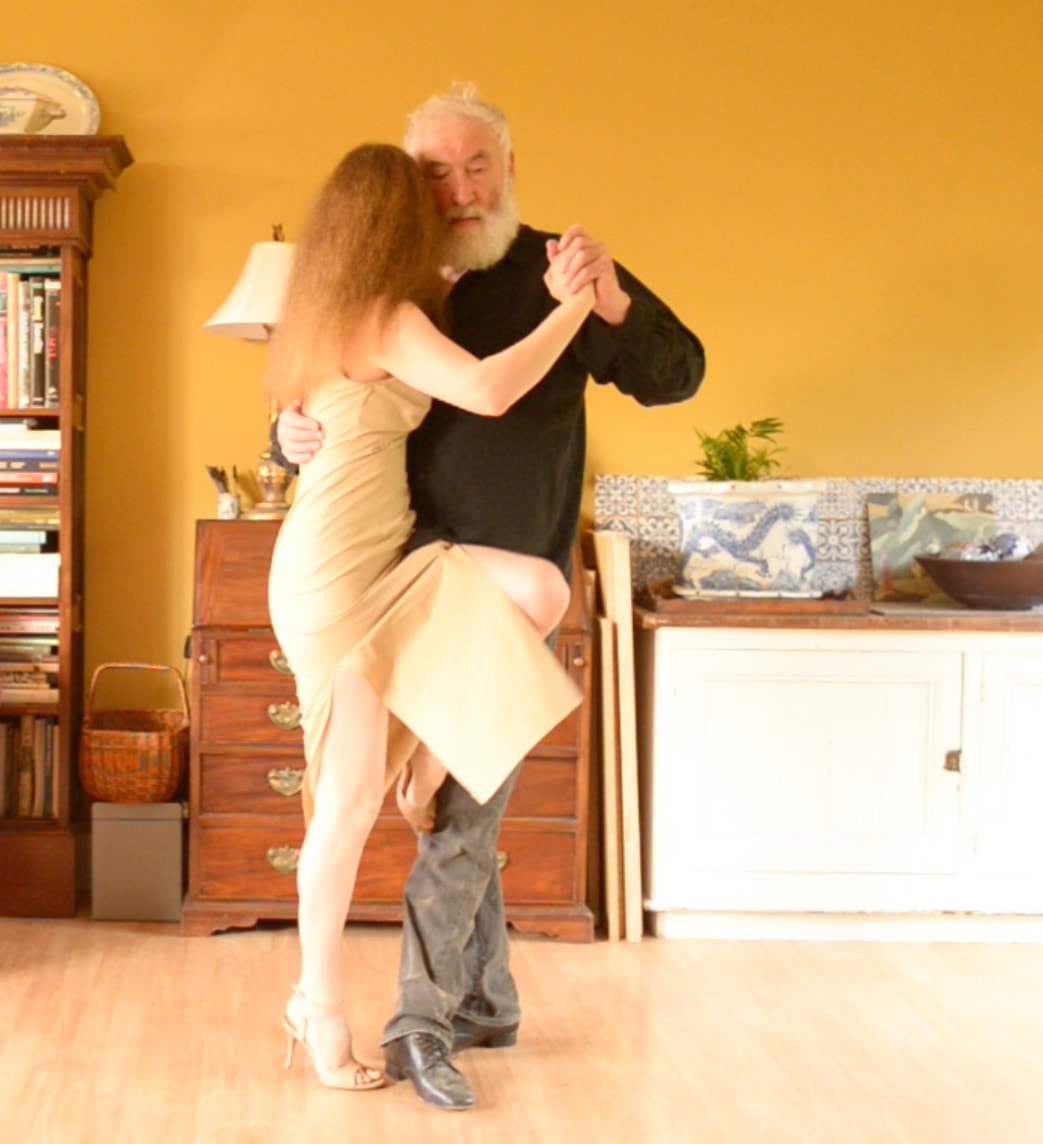|
What to expect in our Workshops and Classes
We teach the original Milonguero tango dance, the tango that was danced when the present Milongueros were young people. The incredible way that the lead and follow communicate directly through their cores; something that leaves onlookers gazing in awe at the seemingly telepathic connection. The leader seems to hardly move; everything he (or she) leads is amplified and embellished by the follower, who is also relating it to what she (or he) feels about that particular piece of music at that particular moment in time. You will dance a lot at our workshops. We know that new movements of the body need to become asimilated into your muscle memory by actually dancing them repeatedly until it feels natural and efortless. The classes are kept small so that we can make sure that everyone is getting all the help they want. We teach through a series of workshops because we believe that everyone should find the technique from the very beginning of theirlearning tango. During the workshop day there is not the time to forget what you have already covered; something that happens during weekly classes from one week to the next. What is tango? Tango is an intense dance characterised through the sheer pleasure and enjoyment of the dance and its music. It is passionate and sensual and focuses entirely on the connection between the dancers and their interpretation of the music. The ultimate tango is through the potential for a shared axis and close embrace because this embrace creates the most effective way to lead and follow. BEGINNERS
Sunday 5th April 2020 'Beginners Tango Immersion' Future dates normally on the first Sunday of each month |
WORKSHOPS
Sunday 22nd March 2020 Enliven your vals Sunday 19th April 2020
'Barridas y Pasadas' |
Miriam Gita and Stephen Vince dance challenging, spontaneously improvised Argentine tango with real flair and elegance
|
|
|
|
Information about these improvised dances at the bottom of this page - just scroll down
Have a look at our other youtube videos showing the way we dance and some clips from our teaching.
Just click The Joy of Tango Videos and Subscribe to receive our new video posts
Have a look at our other youtube videos showing the way we dance and some clips from our teaching.
Just click The Joy of Tango Videos and Subscribe to receive our new video posts
Miriam Gita and Stephen Vince tango teaching is based on the ergonomics of movement. With years spent studying the inner workings of the body to discover deep down how two people can move as one, harmoniously and with fluidity to create a natural and comfortable tango dance. They also focus on guiding their students to feel their own personal connection with the music and use that inspiration to spontaneously interpret and improvise their movements within their dance.
Both Miriam and Stephen have gained a wide range of experience teaching dance and tango and have developed a unique methodology based on the principle of building up the student's technique in layers and therefore offering a mixed-level learning environment which is challenging to all levels. Muscle memory and awareness of the style and aesthetic of Argentine Tango are reinforced by exercises directed to the How for each type of movement.
The Joy of Tango
... is in the music, the atmosphere, one's partner of the moment and
finding joy in the smaller things.
Argentine Tango is such a special dance
in its unique system of 'invisible' lead and follow
Its secret lies in listening
... listening to the music
... listening to one's partner
and responding to both at the same time ...
silently
Both Miriam and Stephen have gained a wide range of experience teaching dance and tango and have developed a unique methodology based on the principle of building up the student's technique in layers and therefore offering a mixed-level learning environment which is challenging to all levels. Muscle memory and awareness of the style and aesthetic of Argentine Tango are reinforced by exercises directed to the How for each type of movement.
The Joy of Tango
... is in the music, the atmosphere, one's partner of the moment and
finding joy in the smaller things.
Argentine Tango is such a special dance
in its unique system of 'invisible' lead and follow
Its secret lies in listening
... listening to the music
... listening to one's partner
and responding to both at the same time ...
silently
Intensive Workshops
We teach through a series of Specialist Workshops. The groups are limited in size to ensure plenty of individual attention is given to each of you. This also enables us to teach mixed-level groups as each particpant's tuition is tailored to their specific needs. We regularly publish details of exciting upcoming workshop topics. All details listed on our workshops page. No need to bring a partner but booking is essential. Email: [email protected] or call/text 077 067 467 50 to reserve your place.
Miriam Gita and Stephen Vince bring you The Joy Of Tango with their unrivalled tuition
|
|
|
|
|
|
|
|
Some interesting facts and info about the Youtube film clips on this page
|
Vals - María Esther by Quinteto Pirincho
María Esther Gamas was born on April 21, 1911 in Rosario, Santa Fé, Argentina. She was an actress, known for Amor libre (1969), Savage Pampas (1945), Consejo de tango (1932) and Mi noche triste (1951). She sang tangos and milongas in dozens of live musicals, earning a reputation for her astute and witty style. Argentine tango vals musical interpretation by Miriam Gita and Stephen Vince to the vals María Esther by Quinteto Pirincho. Stephen and Miriam remain in the milonguero apilado embrace in order to achieve the most acute connection and so sense each other's intentions and interpretations of the music. |
La Tablada by Edgardo Donato
La Tablada in 1936 was the hub and most important part of Argentina's economy where all the cattle arrived to the then outskirts of Buenos Aires thus making Argentina one of the richest countries in the world. Not to be confused as a tango with more recent connotations of La Tablada as a name, particularly since the 1980's. The uplifting buoyancy of the music reflects the economic prosperity of Argentina in 1936. This sentiment comes through during this spontaneous interpretation of the music. |
|
Milongueando en el cuarento by Anibal Troilo
Milongueando enjoyoment during an Argentine tango demo at a tutorial workshop. Milongueando means going from one place to another hence the casual way we're demonstrating. The workshop was in on the topic of voleos including straight voleos. Milongueando en el cuarenta is a Buenos Aires expression for meandering through the night from one milonga to another. This is the life of a any tango dancer in Buenos Aires, a facet that has also been adopted in Berlin. Miriam is giving a running commentary about specific moves that her students had asked about, including gauchos including leg wraps, voleos and even a sentada. |
Nostalgias by Francisco Lomuto canta Jorge Omar
Enrique Cadicamo, the poet composer speaks of the pain and anguish in his heart after a failed love, wishing to retrieve the joy and laughter but he gets drunk instead. Miriam's dance interpretation as usual comes directly from the music; the music from the poem. The languidly of her movement expresses his numbness interspersed with with moments of longing. Each time one hears those descending notes they return the dance to anguish and despair. Nostalgias: "I want to get my heart drunk/ to drown a crazy love/ which is more like a sickness". |

RECENT PAST WORKSHOPS
Sunday 23rd February 2020
'Making the most of the moment'
Sunday 26th January 2020
'The quality within each step'
Sunday 3rd November 2019
'Shaping for leaders and followers'
Sunday 20th October 2019
'Smooth and Seamless Tango'
Sunday 23rd February 2020
'Making the most of the moment'
Sunday 26th January 2020
'The quality within each step'
Sunday 3rd November 2019
'Shaping for leaders and followers'
Sunday 20th October 2019
'Smooth and Seamless Tango'



